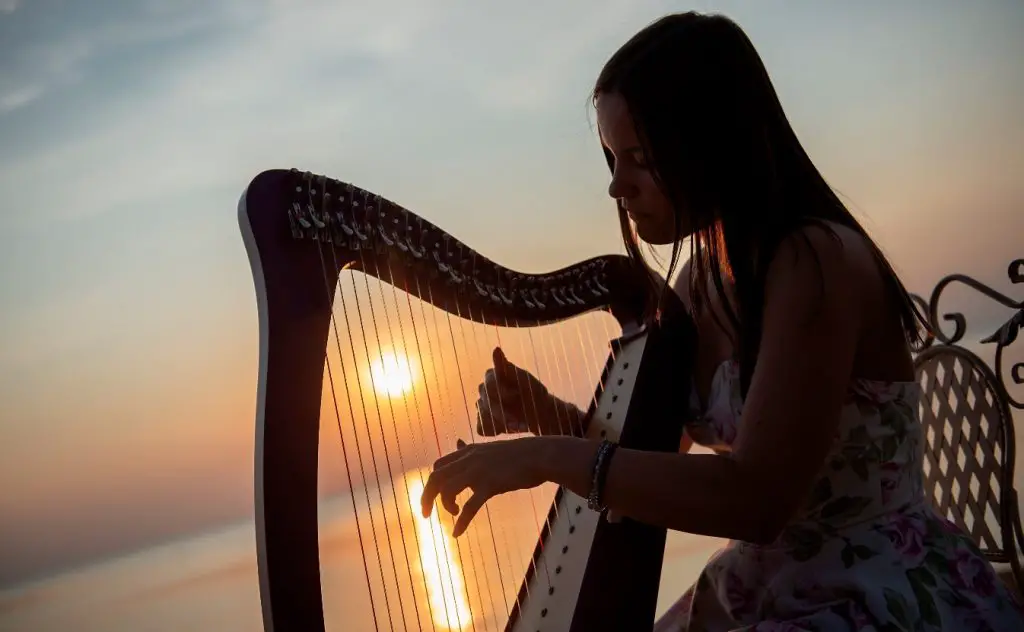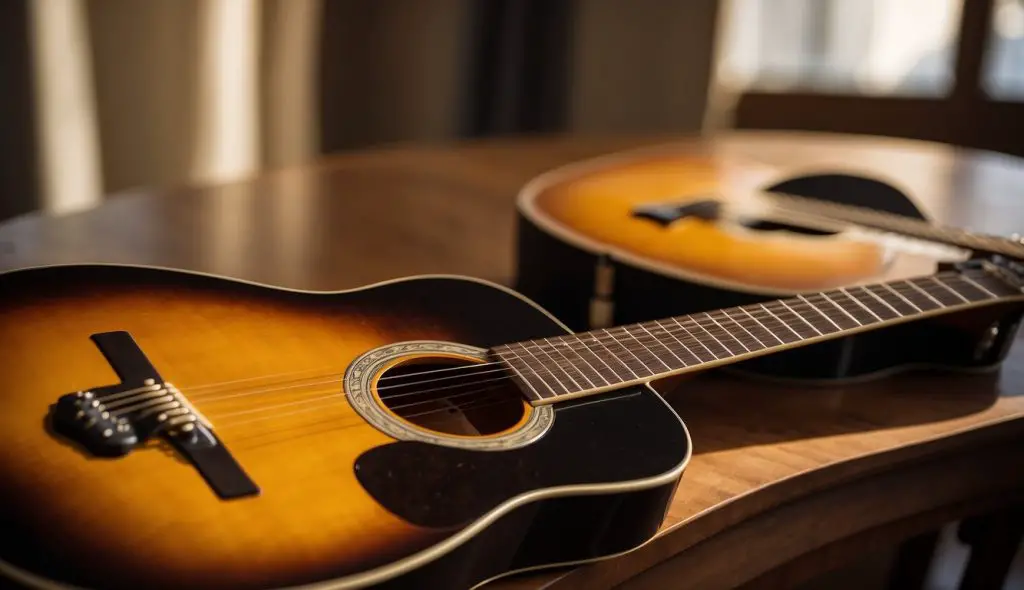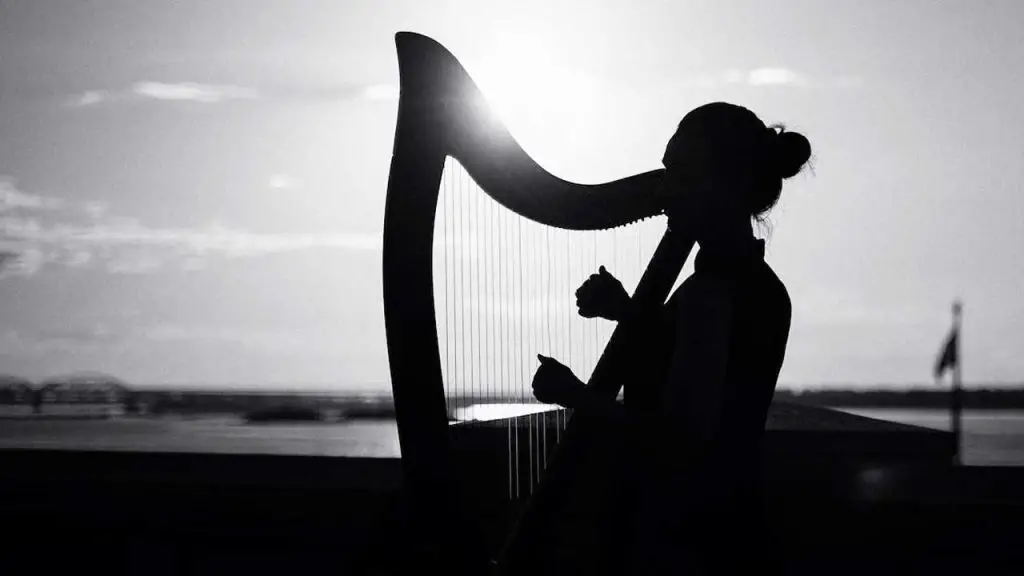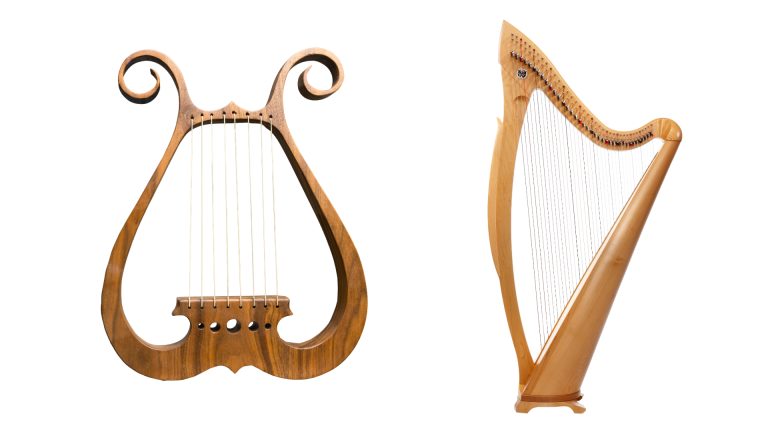Is a Harp Harder Than a Guitar? Understanding the Complexity of These Stringed Instruments
Folkstrings.com is reader-supported. When you buy through links on our site, we may earn a small commission.
When comparing the difficulty of playing a harp to that of a guitar, several factors come into play. The harp, with its many strings and unique playing techniques, presents a distinctive set of challenges.
It demands precise hand coordination and a strong understanding of its complex mechanism, especially when managing the pedals on a concert harp to alter pitch. Meanwhile, the guitar is also challenging, but it is often perceived as more accessible to beginners due to its widespread popularity and the abundance of learning resources available.

The learning process for each instrument is quite distinct. Where guitar strings are typically made of nylon or steel, providing a variety of tactile feedback to the fingers, harp strings are made of gut, nylon, or wire, each with its own response and tension to consider.
Moreover, the techniques for plucking the strings differ greatly between the two instruments. Additionally, the harp’s grand size can make it intimidating at first, whereas the guitar’s portability allows for a more casual, anytime-anywhere approach to practice.
These factors contribute to each instrument’s learning curve, influencing the time and practice required to achieve proficiency. Both instruments enable beautiful musical expression, but the path to that expression differs between the harp and the guitar.
Key Points
- Learning to play the harp involves unique challenges such as pedal coordination and hand positioning.
- Guitar familiarity and resources make it an easy start for beginners, but mastering it still requires dedication.
- Proficiency in both instruments is achievable with dedicated practice, echoing the joy of musical expression.
Table of Contents
Exploring the Harp and Guitar

Before diving into the individual characteristics and techniques of the harp and guitar, it’s essential to understand that both are stringed instruments requiring a unique set of skills to play. They have distinctive physical features and playing styles that contribute to their complexity.
Physical Characteristics
Harp:
- Size and Shape: Harps come in various sizes but typically feature a large, vertical frame. I’ll focus on the pedal harp and the lever harp.
- For instance, pedal harps are grand instruments with a tall front pillar, a sweeping curve of the neck, and a resonant body. Meanwhile, lever harps are smaller and more portable.
- Strings: Harps typically have 46 to 47 strings made from gut, nylon, or metal. These strings vary in length and thickness, producing a wide range of notes.
- Pedals and Levers: The pedal harp has seven pedals at the base, each controlling different sets of strings to change pitches chromatically. Meanwhile, lever harps have levers at the top of each string to adjust the pitch.
Guitar:
- Size and Shape: Guitars have a flat-bodied shape with a narrow neck. Electric and acoustic are common types, but here I’ll focus on classical guitars, known for their nylon strings.
- Strings: Classical guitars typically have six strings, made from nylon for the higher-pitched strings and wound metal for the lower ones.
- Playing Posture: Guitars are usually held horizontally, either on the lap or strapped over the shoulder.
Techniques and Playing Styles
Harp:
The playing techniques for harps can be complex, with both hands being used to pluck the strings in various patterns.
Meanwhile, pedal harps enable intricate harmonic changes mid-performance through the use of pedals. Some styles mimic other instruments like the trumpet or oboe, adding to the harp’s versatility. Hand positioning and strength are crucial for controlling the instrument’s dynamics and resonance.
Guitar:
Guitar techniques involve both strumming with a pick or fingers and plucking individual strings.
The left hand typically forms chords on the fretboard, while the right hand is responsible for rhythm and articulation. Guitars allow for a variety of playing styles, from the strumming of chords to the precise fingerstyle that emulates complex melodic patterns.
Learning Process and Practice

When learning an instrument like the harp or the guitar, I’ve observed that the process involves a good chunk of time mastering the basics and progressively improving skill. Here’s how I break down my practice routines for both instruments.
Mastering the Basics
Harp:
- Body Positioning: I ensure to maintain proper posture, as playing the harp involves using both hands and manipulating foot pedals for larger instruments.
- Finger Placement and Movement: I practice plucking strings with precise finger technique to produce a clear sound.
- Tuning: I often spend time tuning my harp, which can be a meticulous task given the number of strings.
Guitar:
- Chords and Scales: Learning and memorizing basic chords and scales are my first steps.
- Strumming Techniques: I focus on developing a steady strumming pattern to keep the rhythm.
- Finger Dexterity: I work on finger exercises to improve my dexterity and speed.
Progressing in Skill
Harp:
- Advanced Techniques: As I become more comfortable, I include advanced techniques in my routine like glissandos and harmonics.
- Coordination: I concentrate on coordinating hand movements with foot pedal changes to execute complex pieces.
- Sheet Music Practice: I try to read increasingly challenging sheet music to understand melody and harmony.
Guitar:
- Fingerstyle Playing: I gradually introduce fingerpicking patterns into my practice to advance my technique.
- Barre Chords: Mastering barre chords takes patience, and I work on them to unlock more songs and sounds.
- Musical Expression: I experiment with different genres to find my musical voice and improve my improvisational skills.
Musicality and Expression
When exploring the worlds of the harp and the guitar, I find musical expression to be deeply intertwined with an understanding of theory, and both instruments offer unique emotional and physical benefits.
Understanding Musical Theory
For me, theory is the backbone of music, regardless of the instrument.
In terms of melody and harmony, the harp often requires more complex understanding due to its setup. It features a series of strings corresponding to the musical scale, and alterations in pitch are achieved by manipulating the pedals.
On the other hand, adjusting pitch on the guitar is more direct, as I press down on the fretboard. Both instruments let me play various musical genres, from lilting folk tunes to complex jazz improvisations.
But the depth of sound from a harp, with its resonant cavity, provides a unique avenue for artistic expression that is rich and often orchestral in feel.
- Musical Genres on the Harp:
- Classical
- Jazz
- Folk
- Pop
- Musical Genres on the Guitar:
- Rock
- Blues
- Jazz
- Folk
- Metal
Emotional and Physical Benefits
I’ve found that playing the harp has unique physical benefits; it’s like a dance of the fingers, improving my dexterity and coordination. The broad range of motion tends to be a gentle workout for my arms as well.
Meanwhile, the guitar is more contained but can also provide relief from stress given its less demanding space requirements and ease of picking up and playing.
Emotionally, both instruments allow me to express my feelings through the music I create. A melancholic tune or a bright, lively melody can reflect my emotions or sometimes even help alleviate feelings of anxiety.
The repetitive nature of practicing scales or specific pieces on either instrument can foster a meditative state that is fantastic for my mental well-being. My motivation to play is often fueled by the joy and expression I find in them.
Emotional Benefits:
- Expression of emotions through music
- Stress and anxiety relief
- Meditative states through practice
Physical Benefits:
- Improved dexterity
- Coordination
- Gentle arm workout (harp)
- Easier physical accessibility (guitar)
Frequently Asked Questions
I’ve gathered some common questions people tend to ask when comparing the harp and the guitar, especially regarding their playability and learning curve.
What are the main challenges for beginners starting on the harp compared to the guitar?
At the outset, the harp’s intricate string arrangement and playing technique represent a steep learning curve.
The requirement to coordinate hand and foot movements for changing pitches adds to this complexity, a fundamental challenge beginners face that is less prevalent with the guitar.
How does the complexity of playing the harp compare with other instruments?
The complexity of the harp can be compared to that of the piano. Both require considerable finger independence and coordination. However, each instrument has its own unique challenges.
The harp often necessitates distinct physical techniques like striking and dampening strings. It also requires the use of foot pedals in pedal harps.
Can someone with guitar skills easily adapt to playing the harp?
Guitarists may transition to the harp with some advantages due to their finger dexterity and musical knowledge.
However, they must adapt to a different string layout and playing posture.
They also need to learn new techniques specific to the harp, such as engaging levers or pedals to change keys.
What’s the expected time frame to become proficient at playing the harp?
Proficiency on the harp can vary greatly from person to person. On average, a few years of dedicated practice are typically necessary to become comfortable and fluid in playing the instrument.
Mastery, of course, may take considerably longer.
How does the physical technique of playing the harp differ from the guitar?
The technique of playing the harp involves distinct hand positions. Harpists use both hands to produce melody and accompaniment, often simultaneously.
Unlike the guitar, where one hand primarily strums or picks while the other frets, harpists must also manage the spacing and resonance of a much larger array of strings. In the case of pedal harps, they must also handle the coordination of foot pedals.
Are lever harps considered a good starting point for beginners?
Lever harps are indeed considered well-suited for beginners. This is because of their smaller size and relative simplicity compared to pedal harps.
They allow new players to focus on hand techniques. This is without the added complexity of using foot pedals to change notes.
Author Profile
-
Daniel Johnstone is an English writer with a love for stringed instruments from around the world.
He shares his love for these instruments through his writing for folkstrings.com, a website dedicated to all things related to folk string music.
Daniel's passion for music started at a young age, and he has since become an accomplished musician, playing guitar, cavaco, and recently, the harp.
His dedication to learning and sharing his knowledge of stringed instruments is evident in his insightful and engaging blog posts. Whether you're a seasoned musician or a beginner, Daniel's writing is sure to inspire and entertain you.
When he's not playing music or writing, you can find Daniel exploring new instruments and seeking out new sounds to share with his readers.
Latest entries
 AutoharpApril 4, 2024What Is the Autoharp Made Of: Exploring Its Materials and Craftsmanship
AutoharpApril 4, 2024What Is the Autoharp Made Of: Exploring Its Materials and Craftsmanship AutoharpApril 4, 2024Is Autoharp Easy to Play? Unveiling the Truth for Beginners
AutoharpApril 4, 2024Is Autoharp Easy to Play? Unveiling the Truth for Beginners AutoharpApril 4, 2024What Is an Autoharp Worth? Your Guide to Pricing and Value
AutoharpApril 4, 2024What Is an Autoharp Worth? Your Guide to Pricing and Value AutoharpApril 4, 2024Are Autoharp and Zither the Same Thing? Unraveling String Instrument Myths
AutoharpApril 4, 2024Are Autoharp and Zither the Same Thing? Unraveling String Instrument Myths
Affiliates:
This post may contain affiliate links that at no additional cost to you, the site may earn a small commission. We only recommend products we would use ourselves and all opinions expressed on this site are our own.
Accuracy Advice:
While we strive to provide up-to-date and accurate information, the content in this article may not reflect the most current research or medical guidelines. We encourage readers to do further research and consult with professionals for more personalized advice.
Our Recommendations:
The products and services mentioned in any of our articles are recommended based on our independent research and personal experience. We are not sponsored by any company. We aim to suggest products and services we believe are of high quality and could be beneficial to our readers.



